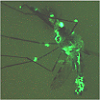A new database developed by Spanish biologists is giving pharmaceutical quick access to protein structure data that could lead to more rapid development of important biologic drugs. The database, known as MoDEL, contains protein motion data for more than 1,700 different human proteins, making it the largest such database of proteins in the world.
Developed through intensive supercomputer calculations at the Barcelona Supercomputing Center, scientists at the Institute for Research in Biomedicine tapped into the international Protein Data Bank (PDB) to create the new video database. Each of the 1,700 proteins catalogued there is displayed through a series of 10,000 to 100,000 photos, showing how the higher order structures of complex proteins move and change. And while 1,700 proteins out of 40,000 may not seem like a lot, many of the proteins logged in the PDB are highly similar - those 1,700 proteins actually represent something like 40 percent of proteins with a known structure.
What does this mean to those of us who aren't biologists? If there’s a “next big thing” in pharmaceuticals, protein therapies are it. While there are still great strides being made in chemically derived, small-molecule pharmacology, biologic drugs - those derived from biology like protein therapies - open up whole new areas of pharmaceutical exploration. This is the area where the last two decades’ advances in understanding the human genome are just starting to pay off, hopefully leading to treatments for everything from inflammatory diseases to cancer.
But in order to create effective and safe protein therapies, pharmaceutical makers must first understand the structures of the proteins they hope to manipulate. Currently, most drugs are designed around a static picture of proteins, which - like most living things - are anything but. By offering researchers a clearer picture of how protein structures move and change, it should help them more quickly identify new potential therapies and reduce failures in clinical trials.
The 1,700 proteins, now partially available online to researchers worldwide, are just the beginning, as MoDEL will continue to grow as more proteins are better characterized. The researchers behind the project hope to have 80 percent of proteins relevant to treating human diseases available in MoDEL within two to three years.





